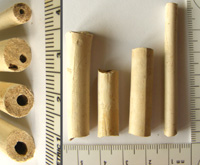Tobacco pipe stems

Click ^ for larger image.
The stems of broken clay tobacco pipes are a relatively common find. The great majority have no decoration and are simply slightly tapering tubes. Some pipes had a stem as long as 400mm, but many were less than half that length. Wide pipe stems such as three of those illustrated, with an external diameter of 10mm, would come from near the bowl on a pipe with a very long stem. It is practically impossible to tell whether a narrower stem (such as the single example illustrated) came from near the end of a long stemmed pipe, or from anywhere along a short stemmed pipe.
The diameter of the hole through which the smoke was drawn from the bowl can vary considerably - four sizes are illustrated. This hole in the pipe stem would be formed when the clay was still wet, by pushing a rod through it. A strong, thick rod was needed to skewer a long stem because a weaker rod would bend under the pressure of being forced through the clay, and would burst out through the side, ruining the pipe. But, as technology improved and stronger rods were developed, they could be made thinner, and this may offer us a relative chronology. In the photograph, the thick stem with the large diameter hole (on the left) is older than the two other thick stemmed pipes, whose holes are progressively smaller.
The thin stem (pictured on the right) is the type most frequently found, and is unfortunately the most difficult to date using this technique because even early pipes could be made with thin rods if they had short stems. But at least the narrow hole means we can be confident this is not a part of a long stemmed, early pipe.
Material: ceramic
Period: Post Medieval (or Modern)
Find spot: Hampstead Road, Brislington, Bristol. ST 612710
Exhibit contributed by Ken Taylor
Text written by Ken Taylor, 2012
Photographer: Ken Taylor
Acquisition number: 120302a7